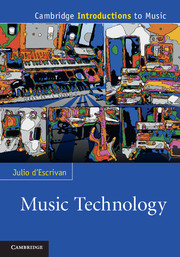Book contents
- Frontmatter
- Contents
- Preface
- Acknowledgements
- Figures
- Chapter 1 Representing and storing sound
- Chapter 2 A studio overview
- Chapter 3 Synthesisers, samplers and drum machines
- Chapter 4 Live music technology (the FAQs)
- Chapter 5 Select, remix, mashup
- Chapter 6 The producer
- Chapter 7 Music, sound and visual media
- Chapter 8 The studio as experimental lab
- Chapter 9 Controllers: new creative possibilities in performance
- Chapter 10 Hacking electronics for music
- Further avenues for exploration
- Notes
- Glossary
- Bibliography
- Index
Chapter 1 - Representing and storing sound
Published online by Cambridge University Press: 05 June 2012
- Frontmatter
- Contents
- Preface
- Acknowledgements
- Figures
- Chapter 1 Representing and storing sound
- Chapter 2 A studio overview
- Chapter 3 Synthesisers, samplers and drum machines
- Chapter 4 Live music technology (the FAQs)
- Chapter 5 Select, remix, mashup
- Chapter 6 The producer
- Chapter 7 Music, sound and visual media
- Chapter 8 The studio as experimental lab
- Chapter 9 Controllers: new creative possibilities in performance
- Chapter 10 Hacking electronics for music
- Further avenues for exploration
- Notes
- Glossary
- Bibliography
- Index
Summary
In this chapter we will describe the basic physics of sound and what an audio signal is. We will look at how we work out sound levels and, in simple terms, some of the maths behind that. We also discuss digital recording and therefore sampling. We describe different ways of representing sound and the way we perceive different frequencies. Finally, we discuss the capture and storage of sound as computer data and the most common standards for carrying digital audio.
What is sound?
First, a problem: to study sound properly, it would be really useful to be able to represent it visually. But sound is, well…sound, a sensation for the ears. When we are able to see sound, what we see is how sound affects other things: the mythical soprano who breaks a wine-glass with a high-pitched warble, or the rippling wave patterns on the surface of a metal plate on top of a loudspeaker. In the same way, to represent sound graphically we need to show how one or more of its characteristics can be visualised. It may be how its amplitude changes over time, or how the different frequencies present in the sound change over time, or, to complicate things slightly, it can be to show how loud those different frequencies are in comparison to one another.
- Type
- Chapter
- Information
- Music Technology , pp. 1 - 20Publisher: Cambridge University PressPrint publication year: 2011

